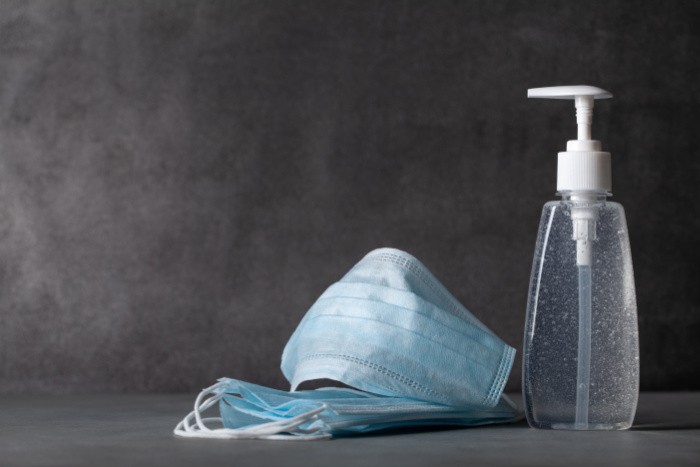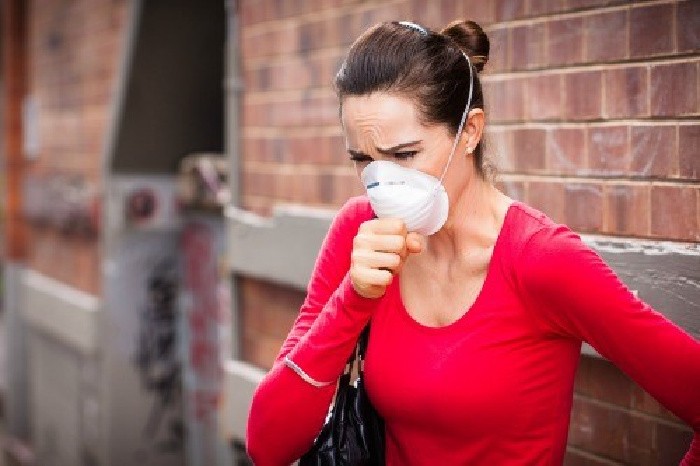
Are you wondering how to stop influenza in your home? Our community here in Northern Utah seems to have been struck by the bug. Has your city been hit hard this year? Some people have developed bronchitis, lung infections, and pneumonia. With flu season hitting neighborhoods across the country right now, I thought it would be a good idea to update this post from a few years ago.
Yesterday, I called my Primary Care doctor to see if I could get an appointment. I actually asked them if I should come and see them or go to Urgent Care. Because of my ongoing oxygen needs, they got me in within an hour. I was lucky and thankful. Well, they tested me for COVID, RSV, Influenza, and Influenza A.
Thankfully, the test goes in your nostrils, and it feels like a feather. Whew, I remember some other ones, I thought they were piercing my brain, of course, they weren’t! LOL! I waited an hour, and the tests were all negative. So I have a virus. A virus, antibiotics do not help a virus.
I basically have a cold. The doctor told me to go home, rest, and drink tea with honey and lemon. Yep, that’s what I had been doing! With the holidays coming up, I wanted to “kick” this so I wouldn’t have to worry about passing it on, and so I could feel better physically during all the festivities.
Matt, one of my friends, had warned me a few years ago that pharmacies were low on OTC medications. He was so right. The pharmacies are limiting how many you can buy. The limit was TWO today. I get it, and I’m thankful I was able to get that many. I did order some online, Vicks NyQuil.
Well, let’s talk about ways to help stop the germs from spreading throughout your home. Please keep in mind that I am not a doctor, nurse, or anyone in the medical field. I’m a mom and a grandma. I want to start with the symptoms of Influenza versus a cold.
Let’s compare the two based on my research. Please check with your medical doctor if you have any concerns. When in doubt, call your doctor, or if you think it is serious, go to the emergency room.
A Brief History of Influenza: How a Single Virus Shaped Human History
Influenza has been around far longer than modern medicine—and it has left a dramatic imprint on human history. From ancient descriptions of mysterious fevers to the devastating pandemics of the last few centuries, the flu has repeatedly reminded us how powerful a tiny virus can be.
Early Mentions: Influenza Before It Had a Name
Historians believe influenza-like illnesses have been circulating for thousands of years. Ancient Greek physician Hippocrates, writing around 400 BCE, described epidemics that match what we now know as influenza. These early outbreaks spread quickly across regions, suggesting that flu has always been a highly contagious respiratory infection.
However, because there were no microscopes or germ theory at the time, influenza was thought of as a “seasonal fever.” People blamed cold weather, foul air, or even planetary alignment—hence the name “influenza,” derived from the Italian word for influence, as in the “influence of the stars.”
Pandemics Before Modern Medicine
As trade routes expanded, so did disease. Influenza outbreaks swept across Europe multiple times between the 1500s and 1800s. These weren’t small outbreaks—some were global events long before the term “globalization” existed.
The 1580 Pandemic
One of the earliest well-documented flu pandemics occurred in 1580, beginning in Asia and spreading to Africa and Europe. It was so severe that entire communities shut down, churches canceled services, and cities imposed early forms of quarantine.
The 1918 Spanish Flu: The Deadliest Pandemic
No history of influenza is complete without the 1918 Spanish Flu, the most catastrophic influenza event ever recorded. Emerging near the end of World War I, it infected roughly one-third of the world’s population and caused tens of millions of deaths—more than the war itself.
What made it so severe?
- It targeted young adults, not just the very young or the very old.
- It spread rapidly through crowded military camps and global troop movements.
- Medicine at the time lacked antivirals, vaccines, or modern hospital care.
The 1918 strain reshaped global public health, prompting better surveillance, hygiene campaigns, and eventually the development of flu vaccines.
The 20th-Century Pandemics
Influenza continued evolving and reemerging:
1957 – The Asian Flu
Originating in East Asia, this H2N2 strain caused a significant global outbreak. Thanks to better communication and rapid vaccine development, the death toll was lower than in 1918.
1968 – The Hong Kong Flu
Caused by an H3N2 strain, this pandemic spread quickly but occurred in a world with antibiotics (for secondary infections), improved healthcare, and established vaccination programs.
1977 – The Russian Flu
A mild H1N1 pandemic that primarily affected young people. Some scientists believe the virus may have escaped from a laboratory, though its origins remain debated.
21st Century: Modern Flu and Ongoing Evolution
In 2009, the world saw the H1N1 “swine flu” pandemic, which disproportionately affected younger populations. Fortunately, it resulted in fewer severe outcomes than earlier pandemics, partly due to rapid vaccine development and improved critical care.
Since then, seasonal flu has remained a predictable—yet ever-changing—annual challenge. The virus mutates continuously, which is why the flu vaccine is updated every year.
What We Know Today
Thanks to global surveillance and modern science, researchers can track influenza strains across continents. We now understand:
- Influenza viruses mutate rapidly.
- Birds and pigs are familiar sources for new strains.
- Vaccination remains the most effective prevention tool.
- Public health systems can respond quickly to outbreaks.
But even with all this progress, influenza is still far from gone. It’s a part of human history and will likely remain part of our future.

How To Stop Influenza In Your Home
Here are the symptoms listed below.

Influenza
Influenza is fast and abrupt when it hits you.
- A sore throat
- May have a fever
- Chills
- A headache
- Extreme exhaustion or fatigue
- May have body aches
- Sneezing, sometimes
- Stuffy nose, sometimes
- Children may vomit or have diarrhea
- Chest hurts, cough is common
Colds
Gradual onset, you start to feel like you are coming down with something.
- Fever is rare
- Scratchy throat
- Aches very slightly
- Chills not common
- Sneezing is common
- A stuffy nose is common
- A headache is rare
- Chest hurts, cough is mild to moderate
I hope this gives you an idea of the possible differences between the two illnesses. The complications would be sinus infections, earaches, bronchitis, pneumonia, and lung infections, to name a few.
Stop Influenza Tips:
- Wash your hands often.
- Cover your mouth when coughing, preferably on your shoulder if a tissue is not available, and throw it in the trash can.
- Use Clorox wipes on cell phones, home phones, light switches, TV remotes, and other electronics, as applicable.
- Avoid touching your eyes, nose, and mouth; doing so will spread the germs big time.
- Keep your house clean.
- Scrub countertops with applicable cleaners every day during flu season (I use Clorox wipes).
- Please wash your hands, yes, I already mentioned this one, it’s critical.
- Keep your bathrooms clean, and don’t forget to clean the flush handle. Clean Bathrooms by Linda
- Empty waste paper/trash cans daily.
- I use doTerra Breathe to keep my sinuses in check (update because I’m on oxygen, no more essential oils or Vicks VapoRub). I miss my Vicks, I really do.
- Stay hydrated with water, Gatorade, or other electrolyte drinks. I’d try to get the drinks in transparent colors rather than those with deep reds or blues. Have you tried LMNT? I stock it now because it’s a great electrolyte package I can store in the pantry.
- Stock your favorite over-the-counter drugs so you don’t have to go to the stores when you REALLY need them.
- Keep chicken stock on hand to make soups.
- Hold off on cow milk products; they may increase mucous (keep breastfeeding your baby).
- Eat a lot of fresh fruits and vegetables.
- Keep your immune system strong, we are we eat, that statement is so true.
- Put humidity in the air with a humidifier, whether warm or cool.
- Keep kids hydrated; the toddlers don’t always know they need water (watch for chapped or shiny lips).
- Change your bed sheets at least weekly, or more often, to stop the germs from spreading.
- Change pillowcases often, as germs can hide in them.
- Replace toothbrushes often or soak them in an antibacterial mouthwash or hydrogen peroxide overnight.
- Using mattress pads and pillow covers will also help reduce the spread of bacteria and viruses.
- Rosa, another reader, mentioned using oregano essential oil. You’d use it with a carrier, such as coconut oil, and apply it topically, diffuse it, take 1-2 diluted drops, or gargle diluted drops for sore throats. Please use with caution, and check with your medical professional.
- Linda S. mentioned keeping a supply of popsicles in the freezer helps keep kids & toddlers hydrated. You can’t make them drink, but I’ve yet to see a child turn down a treat!
- Viv reminded me of the dirty grocery carts and door knobs. Wipe down the doorknobs with Clorox wipes.
- Carol mentioned using elderberry syrup or tablets, Sambucol, and spraying counters and every handle in the house with hydrogen peroxide.
- Kim mentioned not to forget the gas pump handles! I always grab a paper towel from the window cleaning station, use it to push the buttons on the pump and the fuel button, then use it to hold the gas pump handle before and after filling up. Then, use hand sanitizer as soon as I get back into the car. Thanks for helping all of us remember vigilance is the key.
- Kandyce gives her family Vitamin D to help cut the time they are sick. We all know Vitamin D3 is the best, thanks, Cheryl!
- Ray reminded me about Zinc, I take it every day. It’s my understanding that it helps boost our immunity. Zinc
My Sister’s Garlic Soup


My Sister’s Garlic Soup
Ingredients
- 1- quart chicken stock
- 1-10.5 ounce can mild Rotel diced tomatoes and green chilies
- 5-6 chopped garlic cloves (you can store fresh garlic cloves in the freezer peeled and ready to use)
- 1- chopped onion
- 2- chopped carrots
- 1-2 cooked chicken breasts (optional or two cans of canned chicken)
- Add leftover cooked rice or pasta
Instructions
-
Bring to boil and simmer until the vegetables are ready to eat.
Simple, Smart Ways to Prevent the Spread of Influenza: What Every Family Should Know
When flu season rolls around, it doesn’t take long before someone in the house starts coughing, the tissues run low, and you’re suddenly reminding everyone to “wash your hands!” twelve times a day.
Influenza spreads quickly—but the good news is that a few intentional habits can dramatically reduce your risk. Whether you’re caring for little ones, checking in on older family members, or simply trying to stay healthy yourself, these tips will help keep your home (and community) healthier all season long.
Why Flu Prevention Matters
Influenza isn’t just a “bad cold.” It can bring high fevers, body aches, exhaustion, and can lead to serious complications in anyone with underlying health conditions. Stopping the spread protects not just you but the people you love most.
1. Make the Flu Shot an Annual Tradition
The flu virus changes every year, which is why the annual flu vaccine is so important. It’s updated to match circulating strains and remains the most effective way to prevent severe illness. Think of it as your first line of defense each season.
Please note, vaccines are a personal option; I am only putting it out there for those who want them.
2. Wash Those Hands—Often
Handwashing is one of the most straightforward and most powerful habits you can build. Use warm water and soap, scrub for at least 20 seconds, and don’t forget thumbs, fingertips, and the backs of your hands. When you’re out and about, a small bottle of alcohol-based hand sanitizer is your best friend.
3. Keep Hands Off Your Face
It’s a small thing that makes a big difference. Your eyes, nose, and mouth are direct pathways for germs. The less you touch your face, the lower your risk—especially when you’re in public spaces.
4. Cover Coughs and Sneezes the Right Way
A tissue is best, but if you don’t have one, sneeze or cough into your elbow, not your hands. This tiny change helps protect everyone around you.
5. Stay Home If You Feel Sick
This one is hard for many of us, but it’s essential.
If you’re feverish, achy, coughing, or simply not feeling right, rest at home. Not only does it help you recover faster, but it keeps the virus from spreading at work, school, or church.
6. Disinfect High-Touch Surfaces
Viruses love doorknobs, light switches, phones, remotes, and kitchen counters. A quick wipe-down with a disinfectant once or twice a day, especially if someone is sick, can help stop the spread.
7. Improve Indoor Airflow
Good airflow makes a big difference. Crack open a window when the weather allows, run air purifiers with HEPA filters, and keep air circulating. Cleaner air means fewer lingering viral particles.
8. Give Yourself Space When Possible
You don’t need to avoid people altogether, but during peak flu season, a little extra distance in crowded stores or events can help reduce exposure.
9. Wear a Mask If You’re Sick or Caring for Someone Who Is
Masks aren’t just for significant outbreaks; they’re a practical tool anytime you’re around vulnerable individuals or can’t avoid close contact while ill.
10. Support Your Immune System Daily
Healthy habits don’t prevent the flu on their own, but they strengthen your body:
- Stay hydrated
- Get 7–8 hours of sleep
- Eat nutrient-rich foods
- Move your body
- Manage stress
A well-supported immune system is better equipped to fight off infections.
Several years ago, Mark and I lived in a neighborhood where one particular family seemed to “catch” every bug going around. Well, bossyboots here finally said, after cleaning her house with other women almost monthly, that she needs to clean it to cut down on germs. Her kids were old enough to learn to help keep the house clean.
They could easily stop influenza if they cleaned their house. They had strep throat all the time. I get it, my girls were sick every once in a while, but I was a clean freak, I own it. I also regret it now, after all these years. But they learned what a clean house should look like.
Final Word
Influenza may be a seasonal visitor, but it doesn’t have to take over your home. With just a few consistent habits, you can lower your risk and help protect the people you care about. Prevention isn’t about fear; it’s about empowerment and simple, everyday actions that add up.
The best way to stop influenza and other contagious diseases is to prevent the germs from spreading. Do whatever you can to stop influenza in your home by cleaning, washing your hands, and staying out of public places as much as possible.
If you really want to stop influenza, stay home when you are sick and keep your sick kids out of daycare centers, preschools, and public schools. Please let me know how you try to stop influenza in your family. What natural remedies do you prefer?
I would love to hear from you. Keep stocking up on water and cans of food. Thanks again for being prepared for the unexpected. May God bless this world, Linda
Copyright pictures: Influenza: AdobeStock_125574879 by Tashatuvang, Coughing: AdobeStock_68907091 by Johan Larson, Garlic Soup: AdobeStock_40354814 by Galina Mikhadishina, Mask and Sanitizer: AdobeStock_330144116 by Julia Sudnitskaya
The post How To Stop Influenza In Your Home appeared first on Food Storage Moms.
from Food Storage Moms
No comments:
Post a Comment